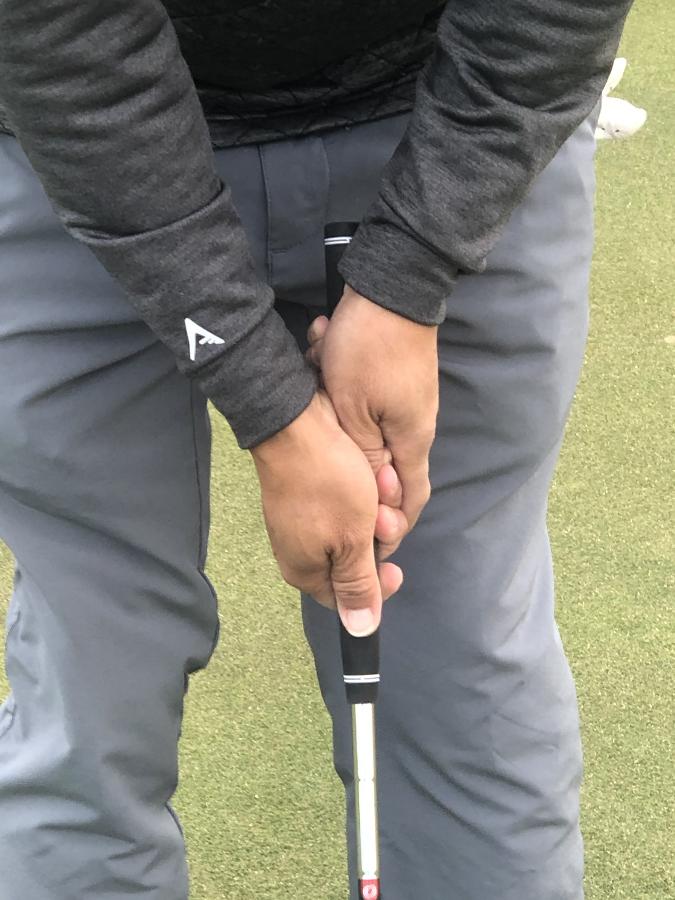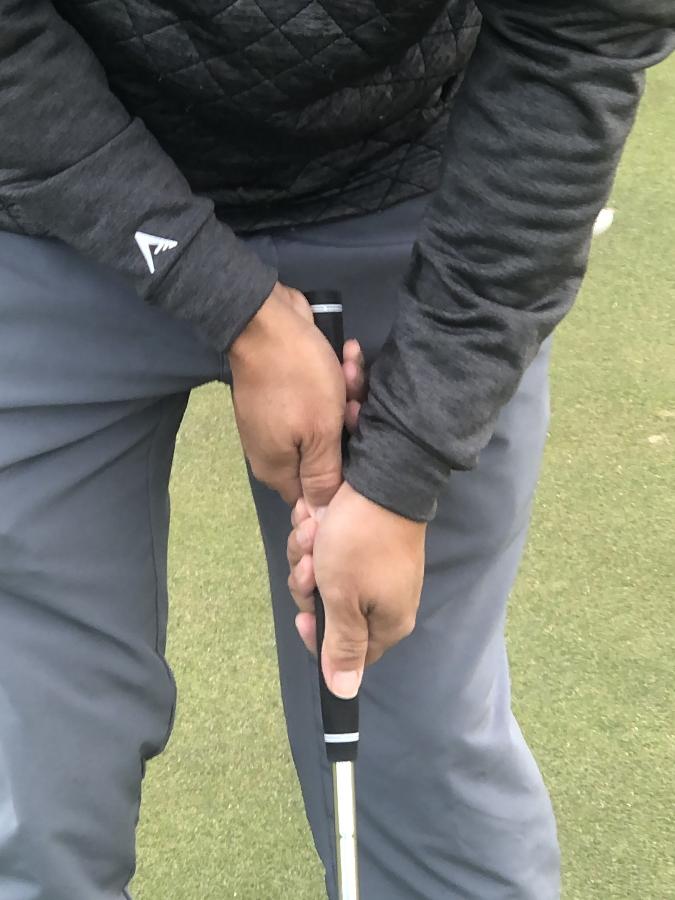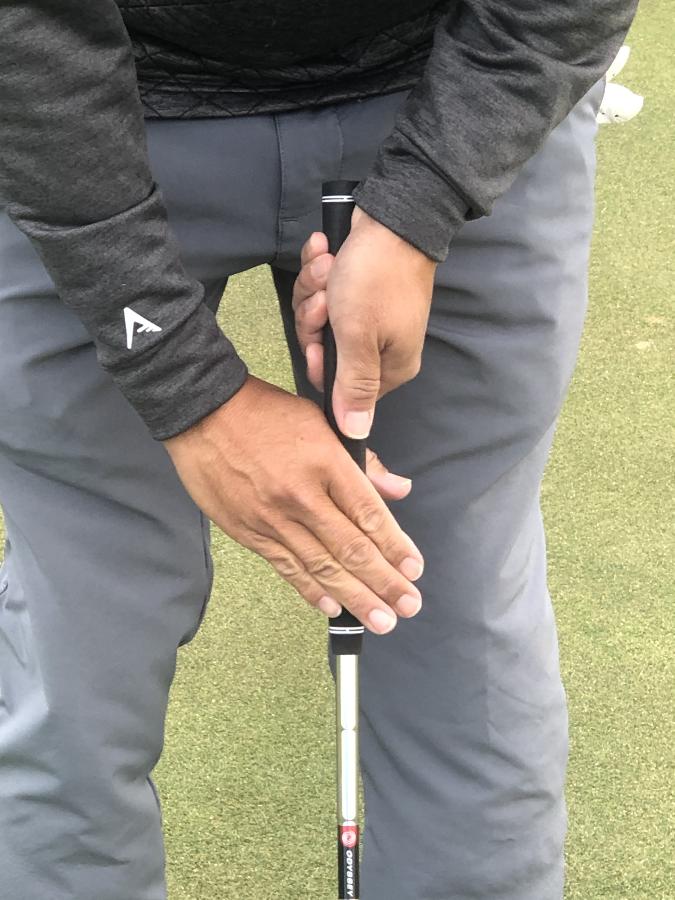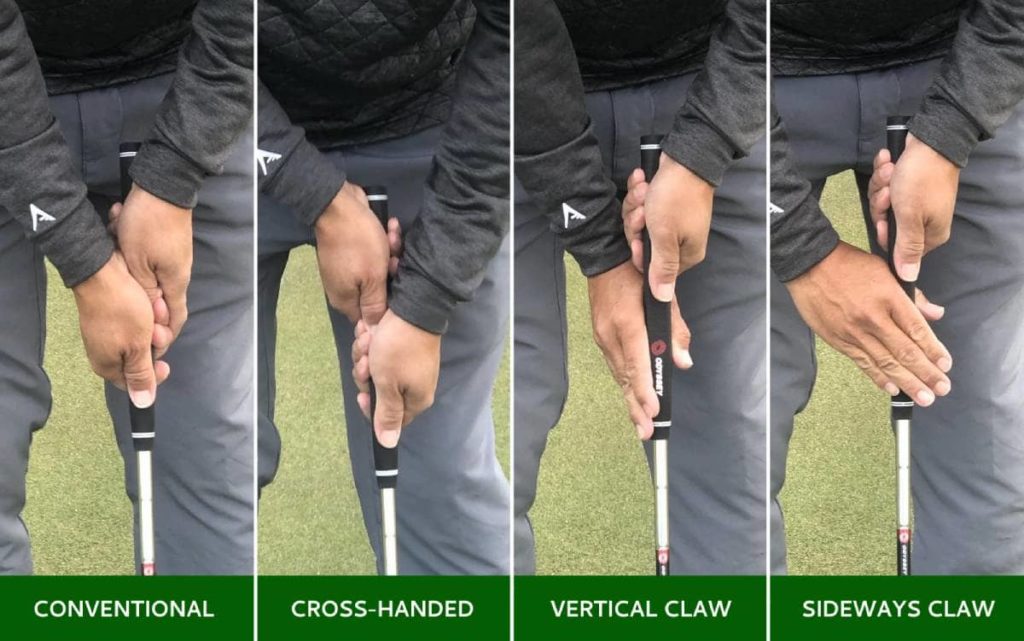Since putting takes up around 44% of your shots, you would think you do it enough to be an excellent putter and putt like a golf pro! The foundation of your putting abilities starts with your putting grip. It’ll give you a fighting chance to make every putt out there on the green.
The way you grip a putter is so important because it can promote a putting stroke that consistently allows for a square impact. If you hold the putter incorrectly it may change your set-up, posture or stance. This will lead to many flaws in your putting stroke which will lead to inconsistent strokes and tempo. A proper putting stroke is when you use more of your upper body and less wrists.
Players often forget to change their putting grip from the full swing grip. The way we hold the regular swing grip promotes rotation around the body and a good release. We need a different turn for a putting stroke and don’t need to harness power so let’s find a comfortable grip that will promote a stroke with a precision focus.
There is no one correct way to grip the putter and changing how you hold the putter is much easier than you think. All golfers – no matter what ability – should experiment with different putting grips. It’s almost like buying new putters without paying for them!
I will go over the different variations of this putting grip but let’s first understand the details on how this grip can make your putting stroke more consistent. There are too many golfers out there just putting with no fundamentals so hopefully this will give you a sense and path of understanding the putting stroke and a reason to practice your stroke, not just trying to put the ball in the hole.
I will explain these grips as if you are holding the putter right handed even though I love teaching left handers…like my son.
Conventional Grip

This putting grip is the most used in the world and on the PGA Tour as it is similar to how you hold the other golf clubs in your bag. There are some changes to your golf grip however as we need to be very precise on our stroke since it is much shorter. We can take advantage of these small changes in your putting grip so try them all out after you understand the reasonings for these changes and the purpose of why we have a different grip than your other golf clubs.
Top / Left Hand
What good putters are doing these days is to stabilize the club in their left hand so they can get the putter face down their target line on the green. Place the putter grip into the middle of your pads in the palm of your left hand. Make sure your thumb is on top of the grip. (This is why putting grips is flat on top so you have a better feel of the putter and to keep it square.)
You want this snug but comfortable during the stroke. This way you can keep the putting grip more stable which will create a consistent angle in your lead wrist all the way through contact. It will also create better momentum of the putterhead with the proper face angle. To keep this angle, you will need to use your shoulders and upper body to control the backstroke keeping your hands and wrists out of it.
Lower Right Hand
Cover the lead hand thumb with your right hand palm to connect both hands. You then want to grab the grip more in your right hand fingers as your thumb goes on top of the grip and now feels like a lower extension of your top thumb. You will want to use your right hand to feel the putter head since it’s lowest and closest to the weight of the putter. You will use the right hand to connect the right arm to drive the putter in your stroke. As you connect both hands, we want them to feel that they are one comfortable unit.
If you did this properly, your palms should be somewhat facing each other. This will reduce the urge to rotate your hands during the stroke as your grip pressure should be moderate at most.
There are many variations of the conventional grip based on what you do with your left hand index finger and your right hand pinky. It is your personal preference on which one feels better to you but hopefully you understand how important your putting grip is if you decide to use the conventional grip.
Left Finger on Top
All of your fingers will be on the putting grip except your left index finger will be resting over most of your right hand fingers. This is a way that will make your grip feel more relaxed with one less finger on the grip.
Reverse Overlap
All of your fingers will be on the putting grip except your left index finger will go below your grip and overlap the right hand fingers between the pinky and ring fingers. It’s similar to the regular overlap grip except that the right hand finger overlaps on top, not the right hand pinky. Make sure you don’t put any excess pressure on the grip.
Ten-Finger
This is most common for beginning golfers and not recommended. This putting grip has all of your fingers on the grip so your hands are not connected in any way besides your left hand index finger resting against your right hand pinky. Using this grip will create excess wrist and hand movements as your hands will have a tendency to take over each other.
Interlock Middle
This grip won’t be found in too many sites as I learned this way back messing around with the grip but you are welcome to try it. The left hand index finger interlocks similar to the regular grip but it interlocks in-between the index and middle fingers on the right hand. This will keep your right hand palm more off the putting grip so could help if you have a tendency to grip the putter too tight.
Inverted Interlock
I actually have been using this putting grip recently and it has given me success. I learned this technique from a fellow golf professional that actually learned this from a student. Bear with me on this because it took me a few minutes to get it right the first time but felt natural when I put it in play.
You hold the putter like you do an interlock grip on your other clubs but instead of your right hand pinky below your left hand index finger, the index finger is below the pinky. So just grip it with the index finger like the Left Finger on Top grip but then sneak it in-between the right index and ring finger so it interlocks, not overlap. It makes me feel that my left hand is weaker but secures the putter better.
Cross-handed Grip

This putting grip is probably the second most popular and fairly easy one to hold. Many also call this the Left-Hand Low, for right handers. You basically just reverse your hands on the grip. This style can help a golfer that uses the right hand too much in the putting stroke. It can also have you level out your shoulders if you have a tendency to set up with a higher left shoulder than your right.
The thumbs line up on top of the grip and all fingers can be on the grip but you can connect the hands by having the left hand pinky or even the ring finger overlapping with the right index or middle fingers. I have a short left hand pinky so it feels uncomfortable to me so I have to bring my ring finger over as well.
This putting grip can give you control by feeling your left side of the body like your arm, shoulder and your left hand to finish the stroke. You can also feel more in control of your stroke as well as keeping the putter face down the line by regulating the tempo more smoothly. This putting grip can also promote you to level out your shoulders at setup which is very important.
I usually put many of my students in this grip to start off when they are new to golf or if they have a tendency to use their wrists too much in their previous grip. One thing this grip can prevent is releasing the putter so make sure you don’t hold that left wrist angle all the way through your stroke.
Vertical Claw Grip

This putting grip is unorthodox but many good putters are starting to use this even on the PGA Tour. It will feel absolutely awkward when trying it out for the first time but you should give it a try after understanding why the best players in the world are starting to use it.
Position your left hand like the conventional grip and just put your thumb on top of the flat part of the grip. Everyone nestles the grip into the left hand palm differently so move it around to help stabilize that putter in that hand. You may also notice that you may grip it tighter in that hand which is expected. Take your right hand and create a “U” with your thumb and then the rest of your fingers. Take that “U” and put it under the lower part of the grip so it is resting gently between your thumb and the other fingers that should be aligned with one another. You will feel your middle three fingers resting up against the right side of the putter grip.
Try to keep the top hand stabilized keeping the wrist angle the same until impact and the bottom hand to use the putterhead for momentum and an easier way to guide your putter down your target line. This will help prevent you from manipulating the putter and putter face.
Sideways (Saw) Claw Grip

This putting grip is similar to the Vertical Claw but is less used. The left hand is exactly the same and the right hand is arranged the same way except that the “U” is positioned on the putting grip differently. The “U” is nestled onto the right side of the grip and angled down so your right hand fingers are pointing ahead of the ball at set-up. It is the same concept as the other claw but you will be guiding the putter more with the “U” which is the pad between your thumb and index finger.
If this Sideways Claw (or Saw) grip looks familiar to you, it’s becoming more popular on the tour and used by Tommy Fleetwood, Justin Rose, Sergio Garcia and was most recently the putting grip used by Collin Morikawa at the Concession Golf Club to win the World Golf Championships-Workday Championship in 2021.
Prayer Grip
This putting grip mirrors something that people do in church or when hitting shots over bodies of water. Not many players use this but can definitely help a golfer if you have a problem with leveling your shoulders at setup. You place both of your hands on the grip at the same level facing each other. Your thumbs will line up against each other as your palms will face each other. The grip should be snug in the middle of your palms and between the middle fingers as well.
Depending on your hand size, a bigger grip may help you secure the putter. Your grip should now look like you are praying with your hands. This grip will promote you to use your upper frame and shoulders and keep your hands and wrists out of your putting stroke.
Arm Lock Grip
This putting grip usually requires a longer putter grip so you will need to find the right length of putter and grip to make it feel comfortable. You will use one of the conventional grip styles if you wish with the long putter grip running up the inside and against the left forearm. This will create a slight lean or forward press in the shaft and will have to maintain that angle through contact.
You will feel that the putter is more stabilized and moving as one unit with shoulders. Make sure your face angle does not decrease the loft to a point that it will make the ball jump at impact.
Broomstick Grip
This type of putting grip requires a long putter and long grip. Not many golfers use this style any longer since the long putters were used to make a stroke that is now banned from the game of golf. They called this “Anchoring” as you could putt while keeping the end of your putter fixed into your chest or belly and using that to anchor your putting stroke. As long as you don’t anchor your stroke, you are able to use this long putter.
Adam Scott is one of a few that uses it professionally these days. He puts his left hand on the top part of the grip with his knuckles facing away from him but puts the thumb on top of the butt-end. There is a small space in between his hands and chest so he technically is not anchoring the stroke even though he keeps the end of his club somewhat fixed and stable.
The right hand can use any grip you seem comfortable with from conventional to a claw version. Adam Scott and others I have seen use this grip chooses the Vertical Claw for the right hand.
This grip style helps you create a smoother stroke because of how heavier the long putters are to the traditional length putters. Smoother strokes lead to the use of more upper body and shoulders for the stroke. Many don’t use it because you are farther away from the putter head so you could lose consistency and feel on short and long putts on the green.
It’s also very heavy to carry and will stick out of your golf bag higher than others. Forget about travelling with them on planes, they will not fit in a golf travel bag.
Putting Grips: Conclusion
If you’ve read this far, congrats on your commitment to learning all about golf putting grips! Your short game and ability to make a greater percentage of your putts may not be sexy, but you’ll love your lower scores and handicap!


